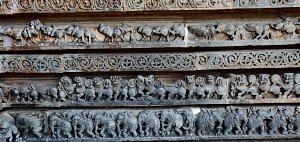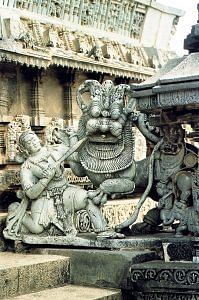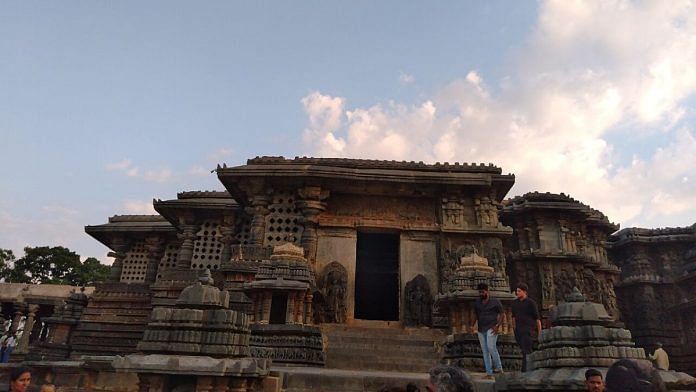Hassan: On an unusually hot day in Karnataka’s Halebidu, a young couple, possibly enjoying an extended weekend in the city’s Hoysaleshwara Temple complex, guns for the perfect selfie. It’s not common for phone cameras to be out in a place of worship, but this is no ordinary temple – it’s one of the three sacred Hoysala-era buildings that recently made it to UNESCO’s World Heritage List.
“They have no interest in history. They just want to take pictures,” the priest mumbles to an Archaeological Survey of India official as the happy couple clicks away.
The magnificent ‘Sacred Ensembles of the Hoysalas’ include three temples built between the 12th and 13th centuries—Chennakeshava in Belur in 1117, Hoysaleshwara in Halebidu in 1121, and Keshava in Somanathapura in 1268. But ever since these temples entered UNESCO’s coveted heritage list in September, the nearby residents have become increasingly worried that their problems would only magnify. Already, they were restricted by the ASI and local authorities from taking up any construction work in their homes. With the heritage tag, they worry that the restrictions would become even more severe.
“My home spans two roads and is suitable for constructing a commercial property, perhaps a hotel or a lodge. But I am not allowed to do anything here,” said 62-year-old Kote Srinivas, who lives in a 50/100 home near Chennakeshava Temple.
According to ASI rules, the 100-metre radius around protected monuments such as the three Hoysala temples is ‘prohibited’, which means there can be no construction work under any circumstances; 200 metres beyond that radius fall within ‘regulated areas’ where any construction work needs prior approval. This forms a 300-metre protective buffer zone around the sites. The Ancient Monuments and Archaeological Sites and Remains (Amendment and Validation) Act of 2010 specifies that no permission for construction shall be granted in prohibited areas.
“These laws have not come in after the UNESCO tag but are earlier ones that are now being implemented. Even those monuments that are not world heritage sites have the same rules of buffer zone,” says Bipin Chandra Negi, superintending archaeologist of ASI’s Bengaluru circle.

Markers of Hoysala architectural prowess, these buildings are nothing short of visual bonanzas. Each wall is replete with hundreds of intricate carvings and captures various aspects of the religious and cultural practices of the time. UNESCO’s World Heritage stamp has added to the allure of these temples, causing a significant jump in tourism.
“We received about 25,000 visitors over the long weekend, as opposed to some 3,000 earlier,” Kumaraswamy, a Hoysaleshwara Temple official, tells ThePrint.
Also read: Vaishnava gods to secular portraits, evolving Thanjavur paintings influenced Raja Ravi Varma
‘Hoy Sala’
Stories of the Hoysala empire’s rise are as fascinating as the glorious rock-cut temples it has left behind.

According to Kannada folklore, a young man named Sala founded the dynasty in the early 12th century after saving his Guru, the Jain monk Sudatta, from a ferocious tiger. During the encounter, Suddata encouraged Sala with the words “Hoy Sala (hit it, Sala)!” as the latter fought and ultimately defeated the animal. Sala later became a powerful king and named his dynasty after his Guru’s cry. This legendary fight sequence is also the emblem of the Hoysala empire and can be found at the Chennakeshava Temple in Belur.
The name ‘Bengaluru’ has similar origins. Hoysala King Veera Ballala II allegedly went astray during a hunting expedition, gradually stumbling upon an older woman’s hut. After the lady graciously fed boiled beans to the hungry king, he named the place “Benda Kal Ooru” (town of boiled beans), which later metamorphosed into Bengaluru.
The empire, which was initially governed from its capital city of Belur, ruled over most parts of southern Karnataka for about 350 years. Dr N Ramesh, a historian and Hoysala period enthusiast, says that about 1,500 temples and Kalyanis (tanks) were built during Ballala’s reign.
“Every village in this Hoysala territory has got a Veera Gallu or a Hero stone, and a Shashana or an inscription stone,” says Ramesh. He is among the several people who rallied for the temples’ inclusion in the UNESCO list.
“Halebidu horage nodu, Belur volage nodu (Look at Halebidu from the outside and Beluru from the inside),” goes a popular Kannada proverb, which is often used to describe the exquisite carvings and architectural beauty of these temples.
The temple at Belur, for one, is among the ‘pancha narayana kshetras’ (five shrines of lord Narayana) established by Hindu philosopher Acharya Ramanujacharya. This temple was established to commemorate the defeat of the Cholas of Tamil Nadu and to mark King Bitti Deva or Vishnuvardhana’s adoption of Hindu Vaishnavism, says Srinivas Bhat, head priest of the Chennakeshava Temple. Originally a follower of Jainism, King Bitti Deva became the great ‘Vishnuvardhana’ under the influence of Ramanujacharya.
Also read:
‘Wedding cake’
Archaeologists have categorised Hoysala temples into three distinct styles. The first consists of a Garbhagriha (sanctum sanctorum) and a Navaranga (hall). The second reflects influences from the Chola, Rashtrakuta, and Chalukya architectural traditions, and the third, more classical one, combines elements from Dravidian and Nagara architecture. The last classification is based on a temple’s Shikaras (towers) and is known as ‘Vesara’, says archaeologist NS Rangaraju, who teaches at the University of Mysuru and specialises in ancient temples.
Rangaraju says that intricate and minute Hoysala temple carvings were made possible because of a ‘special stone’. It contains varying degrees of chlorite, talc and amphiboles and is commonly known as soapstone. “This stone is found only on the banks of the Hemavathi River in [Karnataka’s] Hassan. It is found under the soil, is soft [while under the soil] and hardens when exposed to oxygen. The stone is also not porous as the molecules are compactly arranged, and it is good for minute carving and polishing,” he adds.
Rangaraju claims that British historians documented these temples as “not an inch without carvings.” However, Rangaraju adds, Percy Brown, a British art historian and archaeologist, went a step ahead with his description, aptly calling Somanathpura’s Keshava temple a “wedding cake placed on a tray”.
The entire Keshava temple is on a platform that has a ‘Trikuta’ or three Garbhagrihas. There are also several carvings with no heads, which Rangaraju says are the work of northern armies that followed a practice of destroying local art and culture to assert dominance.
Shaivas and Vaishnavas attacked each other, as well as Jain temples, in a similar manner, adds Rangaraju.
Cut to today, and tourists have made several ‘stone carvings’ of their own, compelling authorities to enforce strict rules and ensure round-the-clock monitoring.
(Edited by Zoya Bhatti)



